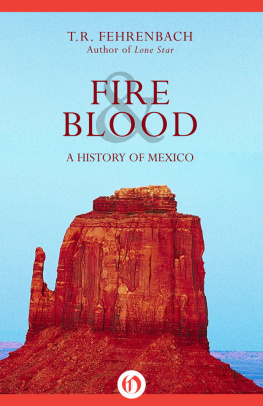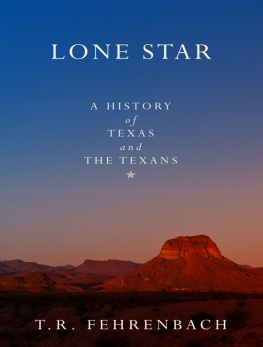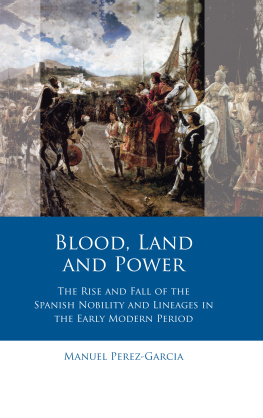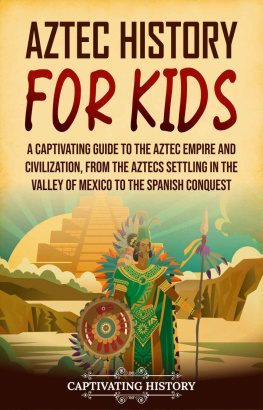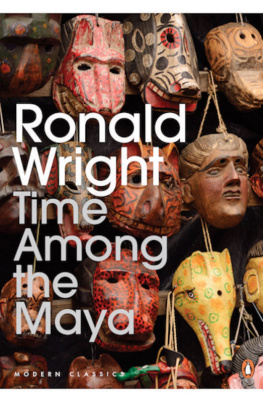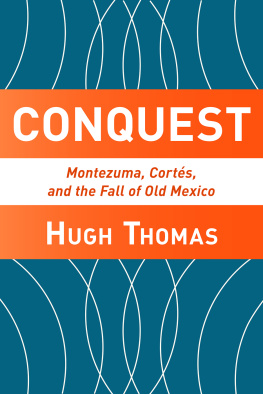Fire and Blood
A History Of Mexico
T. R. Fehrenbach

For My Mother
FOREWORD
Much about Mexico that has recently come to the world's attention is actually old: Modernization, reform, social turmoil, one-party rule, and the struggle to break free from an oppressive past are all themes that have been carried out for generations.
Mexico's present makes no sense without Mexico's past. There have always been many Mexicos, the Mexico of varied terrain, the Mexico of the Amerindian heritage, of the Spanish Conquest, of the Revolution, and of the era when elections and bankers rule. These are all part of modern Mexico, creating not only colorful diversity and vast historic pageantry but also great confusion.
However, through all this diversity and change runs a powerful historic continuity. Mexico has always been a potentially explosive society that, despite upheavals, rests on an inherently stable base. It has always been easier for outsiders to see the color and cruelty, the violent potential, and the suffering of the people than to understand this essential continuity.
This book, written for English-speaking readers, is an attempt both to bring Mexican history to life and to make it intelligible to North Americans. The people of the United States like to believe that political will and good intentions can solve most human dilemmas. They often find it hard to understand Mexicans, who know better. And Mexicans are baffled by people who lack a timeless, tragic view of life. Yet both peoples have something to learn from each other.
Most Mexicans are aware, North Americans less so, that fate has placed both nations upon the same continent, interacting, intermingling, coming constantly closer while remaining strangers divided by their pasts. Yet both heritages are vital parts of the American whole.
And together they will forge its future.
T. R. Fehrenbach
San Antonio, Texas
September 1994
PART ONE
The Tyranny of Circumstance: The Amerindians
Chapter 1
THE OLD ONES
The forces of the past still live on and exert their influence on us, though we may not be consciously aware of this. It is frightening to realize in full depth what it means to be a human being: that is, to realize that we are all imbedded in the flux of generations, whose legacy of thought and feeling we irrevocably carry along with us.
- Kurt W. Marek (C. W. Ceram), Gods, Graves, and Scholars
The rise of man in ancient Mexico is shrouded in mystery.
For that matter, no one knows for certain where or when the human race began, or how it became differentiated and scattered across the globe. Scientists have deduced from the study of skeletal fragments that the genus Homo appeared in Africa during the late Pleistocene era some hundred thousand years ago, with perhaps a half million or more years of cultural evolution already in his past. Bones also indicate that Homo sapiens, true man, the symbol-drawer and weapon-maker, the hunter and killer, began forging into a still subarctic Europe out of Asia about 30,000 b.c. And about the same time, as prehistory goes, human beings also entered the Americas.
The old bones of possible human ancestorslarger apes, pithecanthropi, or hominids such as Neanderthal men have never been found in the Western Hemisphere. The first Americans, tall, erect, gregarious, using fire, wearing animal skins, and armed with flint-tipped spears, arrived from the Eastern Hemisphere.
Thirty to forty thousand years ago, during the last great Ice Age, from which the earth is still emerging, huge areas of the northern hemisphere were covered with glaciers. Ice gripped much of what is now the United States. Southwestern North America, however, was fertile. The high plateaus of these southlands were rich savannahs of waving grasses, dotted with trees and sweetwater lakes. They teemed with mammalian life, and these regions, if not man's cradle, were certainly vast nurseries for the species.
When much of the earth's water supply was locked in glacial ice, the oceans shrank and land bridges rose. One of these connected Asia and Alaska across the Bering Strait. Even during the last Ice Age ice-free valleys and corridors led north and south through Siberia and Alaska. It was through these valleys and across the ephemeral land bridge that the first Americans almost certainly came. They were adventurous and incredibly tough, enduring enormous hardships and traveling thousands of miles.
In relatively recent times ancient human campsites have been found over much of the southwestern United States and the country that is now Mexico. These campsites, the remains of ages-extinct fires, have revealed the bones of Pleistocene animals, artifacts, and tools. The modern carbon-14 dating process exploded many theories by proving that some of these fire-sites are much, much older than previously believedsome dating back approximately thirty thousand years. The animal bones found come from species like the American camel and the woolly mammoth, which have been extinct for thousands of years.
In central Mexico, on the banks of the Rio Atoyac, a mastodon bone has been found that bears unmistakably human carvingssymbols from the brain and hand of man. Nearby, the skulls of other vanished animals have been uncovered, some imbedded with flint points. This same region has revealed hundreds of stone and bone artifacts, abandoned or buried beside the bones of mastodons, elephants, and the small Pleistocene ancestor of the horse. A rock showing the impression of a human hand and containing the skull of a saber-toothed tiger and the femur from a human skeleton which must have stood eight feet tall has been unearthed.
Who were these people? It is impossible to answer dogmatically, because their skeletal characteristics do not seem to resemble any surviving human stock. They had massive teeth set in strong jaws, and curved, flat leg bones. The bones they left behind in limestone and calcified rock are as different from those of later American Indians as the skeletons of modern Frenchmen are from Chinese. This ancient, longheaded people may have been a precursor of the Mongoloid branch of mankind, or they may have been a Caucasoid ancestor.
The few relics these old Americans left tell a great deal: that they were true Homo sapiens, not half-men, that they made weapons and knew fire and used symbols, and that they were the most formidable predators the world had yet evolved.
At that time huge beasts roamed over the high plains of the American Southwest and Mexico. There was the enormous imperial mammoth, and the awe-inspiring American elephant. Mastodons, ground sloths, giant armadillos, and a bison four times the weight of the modern North American buffalo grazed the lush meadows. There were antelope, camels, miniature horses, various cats, snakes, wolves, birds, and bears. Modern men would feel immensely courageous hunting most of these beasts with high-powered rifles; the first Americans killed all of them with flimsy, flint-tipped spears.
The large, curving horn of Middle America was rich, varied, mysterious, and geologically new, with two great mountain ranges thrown up no more than fifty million years before. The mountain chains, or Cordilleras, generally rose from north to south, one on the east facing the green Gulf, the other sloping westward to the blue Pacific. Between these mountain ranges a broad, high central plateau, called the meseta, also rose from north to south, tapering with the horn of Mexico. The center of this plateau, eons ago, was crossed with a smoking volcanic strike, leaving it cut up into countless jumbled valleys.

